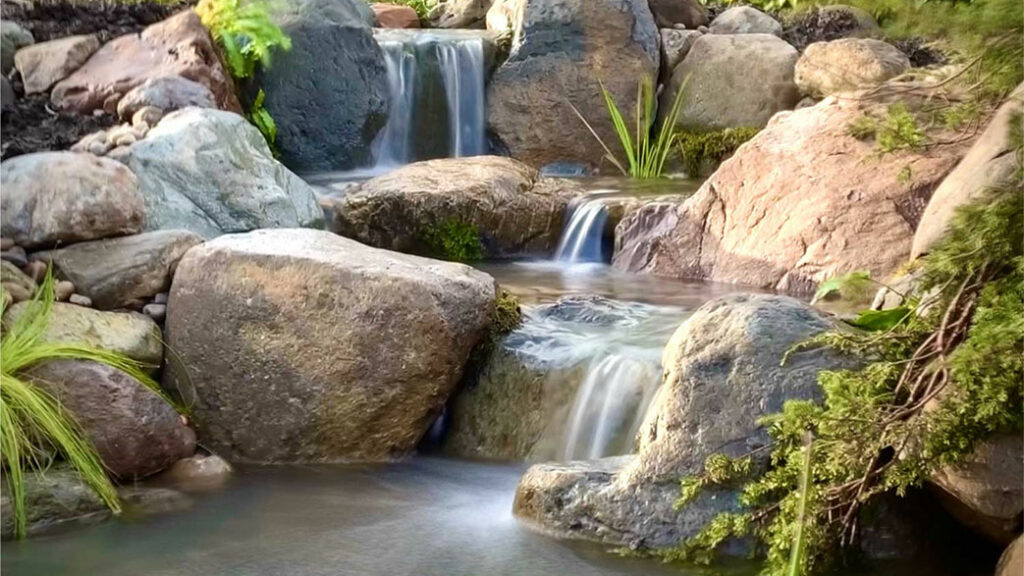
Clean Pond Water: A How-to Guide. Clear water in your pond or water feature is a science but understanding the basics is simple. Clean and clear water is a sign of a healthy and balanced ecosystem. It will mean healthy water, healthy plants and healthy animals.
We need a clean receptacle to start our system off to the best start. If you have something manageable such as a body of water under ~10 x 10m, we are going to give it a drain and clean. Over this size, check out our Lake Facts Blog before coming back to this.
A drain and clean should be carried out every 1-2 years whilst the water temperature is below 10C (typically October-March). This is because most pond life is dormant or has moved out of the pond into your garden so you will cause the least disruption. Remove all of the water from the pond, keeping as much as possible in a paddling pool or buckets, as this is full of good nutrients and microbes which are important. Remove the sludge at the bottom and scrub the sides with a brush until the pond is clean before refilling with your water and topping up with tap water. Rain water that has been kept stagnant in a butt is probably dead water, plus there is very little in this almost pure water, making it very volatile. Tap water is perfectly safe and any residual chemicals will soon evaporate off.
We treat all of our features from bowls to swim ponds and lakes with water treatments. You can dose manually each week or use a Auto Doser to do it for you. This is a shot of pond happiness filled with beneficial bacteria. The treatment will naturally breakdown the excess nutrients in your water, removing the food supply for algae and duckweed. There are four different treatments available that treat slightly different issues as they arise, from cloudy water to fish care and a build up of sludge.
This is the fun bit! Planting up your pond or water feature. The more plants, the healthier your ecosystem will be. We are looking for around 60% coverage to give lots of places for animals to hide but also all these lovely plants are going to be sucking up excess nutrients too.
Oxygen is important for beneficial bacteria to work but any plant that is submerged will be producing oxygen. The “Oxygenators” are particularly good at it as they have a large surface area below the water but if you have a well planted pond, you don’t have to have oxygenators.
Getting a varied mix of plants is important for the wildlife. This is how I like to choose my plants:
The fluffy rafting plant – mazus, creeping jenny, forget-me-nots
This is great for creating a bridge between land and water for animals to climb in and out of. It also disguises the edges of the pond, making them look more natural as they blend between water and land. Their fibrous roots floating on the water will take up nutrients and release oxygen whilst creating places for animals to hide and hunt.
The Evergreen – optic grass, acorus
Keep colour and structure to your pond throughout the year whilst also having those stems submerged for habitats and oxygenating.
The Iris – pseudacorus, louisiana, versicolour
Everyone needs an iris. With their beautiful flowers, they bring a pond to life, plus they create a lovely straight stem for dragonfly nymphs to climb out of the water whilst they transform into their adult form.
The Water Cover – Lilys, Water Hawthorn
These rafting plants create shade and shelter in the water and their floating pads are the perfect place for dragonflies to lay their eggs. With so much of the plant submerged, they are great oxygenators.
Maintenance is always better than cure and so remember to care for your pond to keep it clean. The best thing you can do is to prevent debris dropping into the water. The easiest way is by cutting back dead and dying plants and using a net to regularly clear the surface before they sink. Inevitably sludge will build up but with the high beneficial bacteria working in oxygenated water, this will be slower. If an issue appears, perhaps look at changing your water treatment to something to target that issue before it get’s too big. Pop into Aqua Eden if you need any help, let’s make water gardening fun.

Aqua Eden, Jordans Courtyard,
Ilminster, TA19 9PY
Open Tue-Fri 10am – 3pm
check social media before travelling for any changes
hello@AquaEden.co.uk
We’re the South West’s newest Water Garden Centre and Design Studio, nestled in the heart of Jordans Courtyard, Ilminster, just off the A303 and J25 of the M5. Whether you’re looking to enhance an existing water feature or create a brand new oasis, we’re here to inspire, educate, and empower you on your water gardening journey. Our friendly, knowledgeable team is passionate about helping you bring your watery dreams to life, and we’re with you every step of the way.
If you’d prefer to leave it to the professionals, our partner company, DU Waterscapes, brings years of experience and expertise to the table. As award-winning water feature artists, they offer expert maintenance and custom installations tailored to your needs. Experience their stunning displays at Aqua Eden and discover how they can bring a slice of Eden to your home. Learn more on their website!